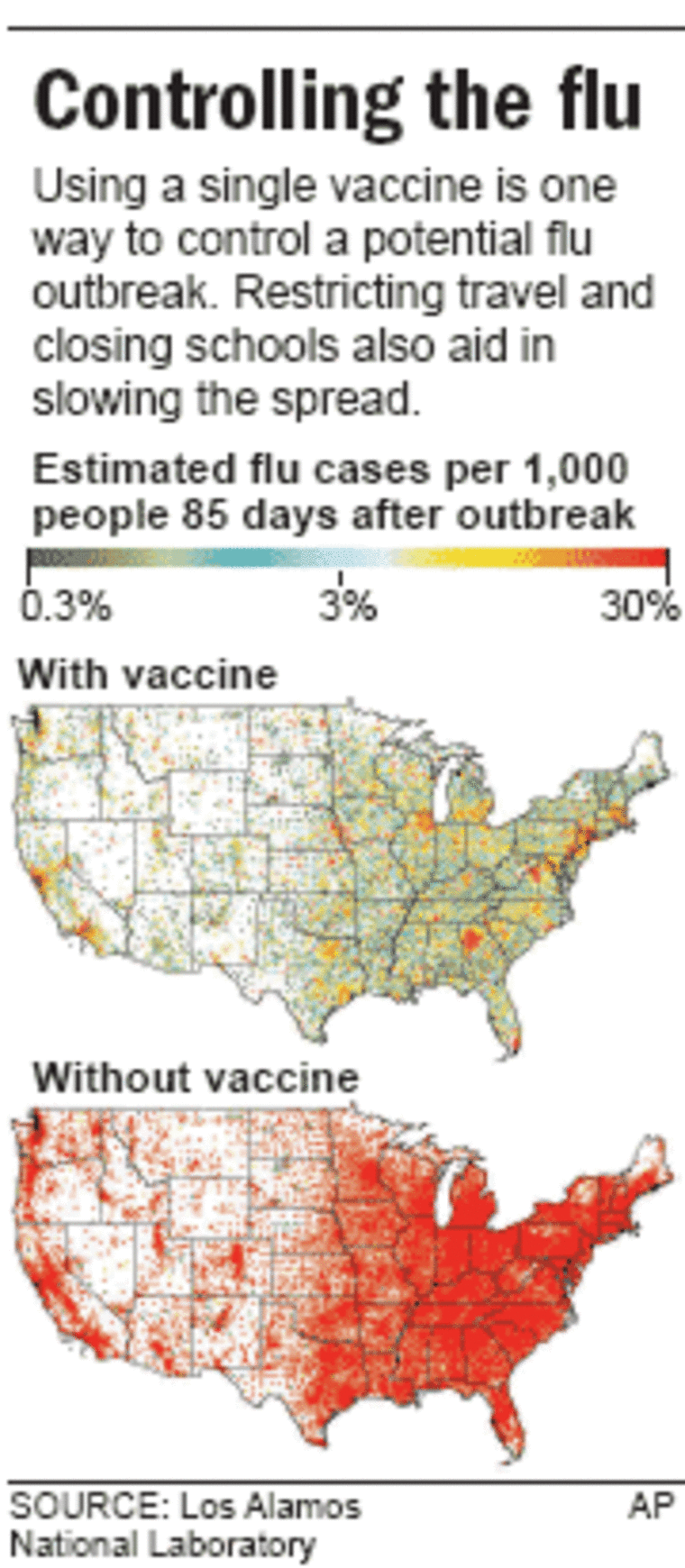The most effective way to combat an outbreak of bird flu in people would require a rapid and aggressive vaccination campaign as soon as the outbreak began, even if the vaccine wasn't a perfect match, a study concludes.
Flu viruses are constantly changing, and a vaccine aimed at a specific strain can't be developed until scientists identify the form infecting humans. That's why the annual human flu shots must be updated every year.
But even a bird flu vaccine that is poorly matched to the form that breaks out would be likely to provide some protection and could help slow the spread of the disease, according to a research team headed by Timothy C. Germann of Los Alamos National Laboratory.
In addition to the vaccine campaign, the researchers said rapid use of several million doses of antiviral medicines such as Tamiflu could help stem an outbreak.

Their findings, developed by using computer models of how flu spread would be affected by vaccines, other medication and social steps such as closing schools and restricting travel, are published in this week's online edition of Proceedings of the National Academy of Sciences.
The outbreak of H5N1 bird flu in Asia has now spread to Europe and scientists are concerned that it could become a worldwide pandemic if the virus changes in ways that enable it to spread easily from person to person.
More than 100 people have died from the virus, but most seem to have contracted the disease from domestic or wild fowl, with the illness slow to spread from one human to another.
If it develops that person-to-person ability and is not quickly contained at its source, "international travel could carry pandemic viruses around the globe within weeks to months ... causing a worldwide public health emergency," Germann's team warned.
Indeed, just last week Dr. Anthony Fauci, the government's leading bird-flu scientist, said he was more worried about the virus arriving in a sick airline passenger than via migrating birds.
Vaccine only partially effective
A vaccine for the bird flu is currently under development and early tests indicate it is effective in about 50 percent of patients, though it requires a much larger dose than the regular annual flu shot. To date, the stockpile is enough for 4 million people with a goal of being able to protect at least 20 million people.
Targeting antiviral drugs to people in the area of flu cases is likely to be effective only during the earliest stages of an outbreak due to the labor-intensive requirements. As the flu spreads a community health system could be overwhelmed by the number of cases, the researchers said.
Because of the importance of children in transmitting the flu, school closures are likely in an effort to reduce exposure to the virus and either legal or voluntary travel restrictions could also occur, the study said.
However, the research team reported, their study indicated that even a 90 percent reduction in domestic travel would slow the spread of the flu by only a few days to weeks and would not reduce the eventual size of the outbreak.
While the vaccine under development requires two doses to be effective, the researchers said the most effective response to an outbreak would be a rapid effort to deliver single doses as rapidly as possible, getting partial protection, possibly supplemented with antiviral drugs.
The spread of flu could potentially be controlled by delivery of 10 million doses of vaccine per week for 25 weeks, they concluded.
In a separate paper also being published online by PNAS researchers said that combining air travel and commercial shipping data with climate information could help indicate areas at risk of epidemics caused by the spread of disease-carrying mosquitoes.
In the report, Andrew Tatem of England's University of Oxford and colleagues analyzed more than 30,000 international ship and aircraft routes. They found the spread of the Asian tiger mosquito — which has not been linked to disease — followed high-traffic sea shipping routes.